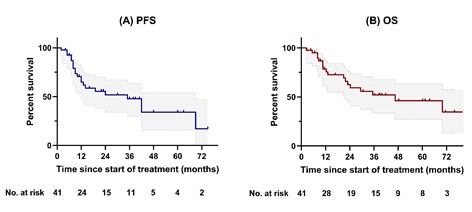
Contributions
Abstract: PB1437
Type: Publication Only
Session title: Aggressive Non-Hodgkin lymphoma - Clinical
Background
Current treatment of primary CNS lymphoma (PCNSL) is a high-dose methotrexate (HD-MTX)-based polychemotherapy. The addition of cytarabine to HD-MTX-based chemotherapy improves clinical outcomes, however the combination therapy increases toxicity. Sequential chemotherapy may decrease toxicity without altering efficacy.
Aims
To analyze efficacy and safety of sequential chemotherapy and cranial radiation for newly diagnosed PCNSL patients.
Methods
This was a single center, retrospective cohort study of consecutive newly diagnosed immunocompetent PCNSL patients treated with HD-MTX (5 cycles of 3 g/m2 every 2 weeks) followed by consolidation WBRT (total 46 Gy) and cytarabine (2 cycles of 3 g/m2/d for 2 days every 3 weeks) from January 2013 to December 2020. Initial WBRT before HD-MTX was allowed in patients with Karnofsky performance status less than 70%. Primary outcome was progression-free survival (PFS). Key secondary outcomes were response rate, treatment-related toxicity, and overall survival (OS).
Results
Of 41 patients, 25 patients had complete response (CR) and 10 patients had partial response, which inferred to an overall response rate (ORR) of 85.4% and a CR rate of 60.9%. More than 90% of patients were able to tolerate and complete HD-MTX. Twenty-one patients (51.2%) received initial WBRT before chemotherapy. The incidence of ≥ grade 3 hematologic and non-hematologic toxicities were 4.8% and 17.1%, respectively. Treatment-related mortality rate was 2.4%. There was no difference in toxicity between patients with age < 60 and ≥ 60 years. At the median follow-up duration of 39.8 months, median PFS was 35.2 months (95%CI 12.4 – 69.3) and median OS was 46.5 months (95%CI 21.8 – NR).

Conclusion
High-dose methotrexate followed by consolidation whole-brain radiotherapy and cytarabine has acceptable efficacy, great tolerability, and low toxicity in newly diagnosed PCNSL patients.
Keyword(s): CNS lymphoma, Cytarabine, Methotrexate, Radiotherapy
Abstract: PB1437
Type: Publication Only
Session title: Aggressive Non-Hodgkin lymphoma - Clinical
Background
Current treatment of primary CNS lymphoma (PCNSL) is a high-dose methotrexate (HD-MTX)-based polychemotherapy. The addition of cytarabine to HD-MTX-based chemotherapy improves clinical outcomes, however the combination therapy increases toxicity. Sequential chemotherapy may decrease toxicity without altering efficacy.
Aims
To analyze efficacy and safety of sequential chemotherapy and cranial radiation for newly diagnosed PCNSL patients.
Methods
This was a single center, retrospective cohort study of consecutive newly diagnosed immunocompetent PCNSL patients treated with HD-MTX (5 cycles of 3 g/m2 every 2 weeks) followed by consolidation WBRT (total 46 Gy) and cytarabine (2 cycles of 3 g/m2/d for 2 days every 3 weeks) from January 2013 to December 2020. Initial WBRT before HD-MTX was allowed in patients with Karnofsky performance status less than 70%. Primary outcome was progression-free survival (PFS). Key secondary outcomes were response rate, treatment-related toxicity, and overall survival (OS).
Results
Of 41 patients, 25 patients had complete response (CR) and 10 patients had partial response, which inferred to an overall response rate (ORR) of 85.4% and a CR rate of 60.9%. More than 90% of patients were able to tolerate and complete HD-MTX. Twenty-one patients (51.2%) received initial WBRT before chemotherapy. The incidence of ≥ grade 3 hematologic and non-hematologic toxicities were 4.8% and 17.1%, respectively. Treatment-related mortality rate was 2.4%. There was no difference in toxicity between patients with age < 60 and ≥ 60 years. At the median follow-up duration of 39.8 months, median PFS was 35.2 months (95%CI 12.4 – 69.3) and median OS was 46.5 months (95%CI 21.8 – NR).

Conclusion
High-dose methotrexate followed by consolidation whole-brain radiotherapy and cytarabine has acceptable efficacy, great tolerability, and low toxicity in newly diagnosed PCNSL patients.
Keyword(s): CNS lymphoma, Cytarabine, Methotrexate, Radiotherapy


